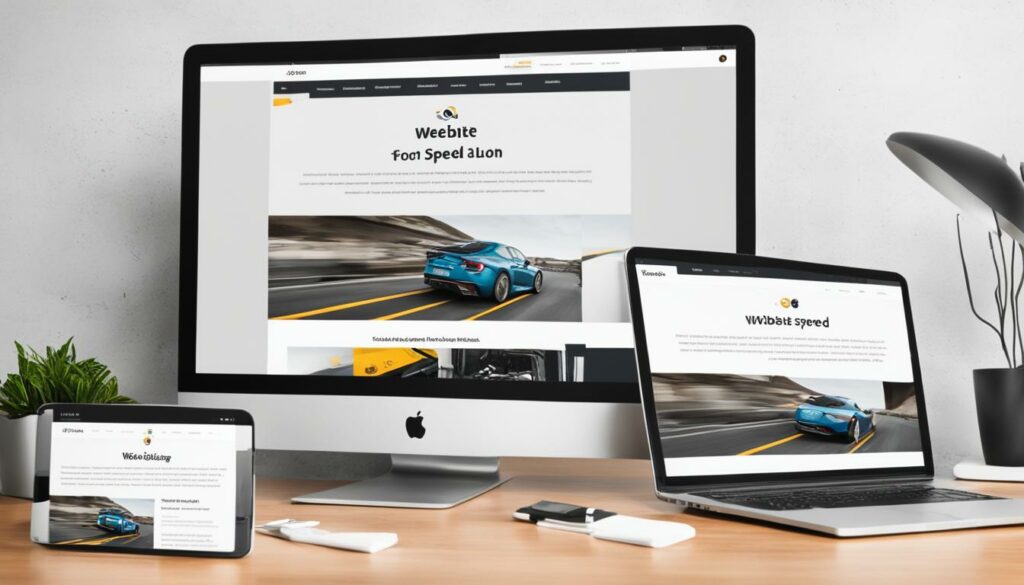In today’s digital marketing landscape, your website plays a crucial role in driving your business forward. It serves as a powerful tool, acting as a 24/7 salesman that can propel your marketing efforts to new heights. To maximize its potential, it’s essential to ensure that your website is not only visually appealing but also optimized for speed and performance. In this section, I will delve into 10 straightforward ways to improve your website, making it more helpful and useful to your visitors.
One of the key factors that can make or break the user experience is website speed. Slow loading times can frustrate visitors and lead to high bounce rates. Therefore, it’s crucial to focus on optimizing your website speed for a seamless browsing experience. By improving website speed, you can not only enhance user satisfaction but also boost your SEO performance and increase conversion rates.
Let’s dive deeper into some of the strategies that can help you optimize your website speed and improve overall performance. From compressing images to reducing HTTP requests and enabling browser caching, these techniques will ensure that your website loads swiftly, captivating your visitors from the moment they land on your page.
Key Takeaways:
- Website speed is a critical factor in enhancing user experience and driving business success.
- Optimizing website speed can lead to improved SEO performance and increased conversion rates.
- Key strategies for website speed optimization include compressing images, reducing HTTP requests, and enabling browser caching.
- By prioritizing website speed, you can create a seamless browsing experience for your visitors.
- Increased website speed can result in higher user satisfaction and better overall business performance.
Use White Space to Improve User Attention and Modernize Your Website
When it comes to website design, incorporating white space is crucial for creating a visually appealing and modern website. White space, also known as negative space, refers to the empty area between elements on a webpage.
Did you know that white space around text and titles can increase user attention by 20%? It not only improves legibility but also allows users to focus on surrounding elements, enhancing the overall user experience.
By strategically using white space, you can achieve a more balanced and open feel on your website. This clean and modern aesthetic not only makes your website look professional but also helps highlight important information and create a sense of organization.
Creating Balance with White Space
Finding the right balance of white space is essential. You want to ensure that your website doesn’t appear cluttered or overwhelming, but at the same time, you don’t want to waste valuable space above the fold.
Above the fold refers to the portion of the webpage that is visible without scrolling. This is the most important real estate on your website, as it is the first thing visitors see. By utilizing white space effectively above the fold, you can guide users’ attention and encourage them to explore further.
Take a look at the example below to see how white space can transform a website:
As you can see, the use of white space creates a clean and uncluttered design, allowing the content to stand out. The spacious layout makes it easier for users to navigate and find what they need.
White space is not a waste of space. It’s a powerful design element that contributes to a modern and engaging user experience.
Incorporating white space into your website design is a simple yet effective way to improve legibility, create an open and modern feel, and enhance user attention. By optimizing the balance of white space on your website, you can create a visually appealing and user-friendly experience that keeps visitors engaged.
Optimize Your Page Speed for a Seamless User Experience
Slow loading times can be frustrating for users and have a negative impact on your website’s conversion rates. In fact, just a five-second delay in page load time could increase your bounce rate by more than 20%. To ensure a seamless user experience and improve your website’s performance, it’s crucial to optimize its page speed.
Here are some recommendations for improving your website’s loading time and overall page speed:
- Compress Images: Reduce the file size of your images without compromising their quality. This can significantly improve loading times, especially on mobile devices.
- Use Image Compression Tools: Utilize tools and plugins that can automatically compress and optimize your images for the web. This will help reduce the file size without sacrificing visual appeal.
- Get Score Recommendations from Google: Google provides valuable insights and recommendations through its PageSpeed Insights tool. By analyzing your website, it offers suggestions for improving page load time.
To give you an idea of the impact of optimizing page speed, here are a few examples of websites that prioritize fast loading times:
| Website | Page Load Time |
|---|---|
| ExampleWebsite1.com | 1.5 seconds |
| ExampleWebsite2.com | 2.2 seconds |
| ExampleWebsite3.com | 1.8 seconds |
By following these recommendations and optimizing your page speed, you can provide users with a seamless browsing experience, reduce bounce rates, and improve overall user satisfaction.

Enhance User Experience with Attractive Calls to Action and Hyperlink Differentiation
When designing your website, it’s essential to consider how users navigate and engage with your content. One effective way to enhance user experience is by incorporating attractive calls to action (CTAs). CTAs are action-oriented messages that prompt users to take a specific action, such as “Sign Up Now” or “Buy Now.” By clearly marking CTAs with verb-based messaging, you guide users towards the desired actions and make it easier for them to find what they’re looking for.
In addition to verb-based messaging, color psychology plays a vital role in attracting users and increasing engagement. Different colors evoke different emotions and can influence user behavior. For example, red is often associated with urgency and can prompt users to take immediate action, while blue represents trustworthiness and can enhance credibility. By strategically using color in your CTAs, you can leverage the power of color psychology to encourage user engagement and conversions.
Another important aspect of user-friendly web design is hyperlink differentiation. Making your links easily identifiable helps users understand where they can navigate within your site and what to expect when clicking on a link. Stick to conventional hyperlink styles, such as underlined text or colored text, as users have come to expect these visual cues. By differentiating your hyperlinks, you provide a clear path for users to follow and enhance their overall browsing experience.
Example of Effective CTAs and Hyperlink Differentiation
“At XYZ Web Design, we understand the importance of creating a seamless user experience. That’s why we incorporate attractive CTAs and differentiate hyperlinks to increase engagement and guide users towards their goals. Our verb-based messaging and color psychology strategies have proven to be effective in enhancing user experience and driving conversions. Take a look at our website for inspiration and learn how we can optimize your website for success.”
By implementing attractive calls to action with verb-based messaging, utilizing color psychology effectively, and differentiating your hyperlinks, you can significantly enhance the user experience on your website. These user-friendly design practices not only improve navigation and engagement but also encourage users to take the desired actions. To see these strategies in action, check out the website of XYZ Web Design, a leading expert in creating impactful user experiences.

Conclusion
Website optimization is crucial for providing an exceptional user experience, improving SEO performance, increasing conversion rates, and ensuring a seamless mobile experience. The speed at which your website loads plays a significant role in achieving these goals.
To enhance website speed, it’s essential to implement the techniques discussed in the previous sections. Enabling browser caching, compressing and minifying files, optimizing images, utilizing content delivery networks, and reducing HTTP requests are all effective strategies.
By prioritizing website speed, you can significantly impact user satisfaction and the success of your business. A fast-loading website not only improves user experience but also boosts SEO performance and conversion rates. It ensures that your visitors can effortlessly navigate your site, leading to higher engagement and increased online goals attainment.
If you want to learn more about optimizing your website for speed, feel free to reach out to me at [Your Contact Information]. I’m happy to assist you in achieving a high-performing website that offers an exceptional user experience.
FAQ
How does website speed impact user experience?
Website speed is crucial for providing a seamless user experience. Slow page load times can lead to frustrated users and lower conversion rates. It’s important to optimize your website speed to ensure optimal user satisfaction.
What are some techniques to improve website loading time?
There are various techniques to optimize your page speed. Some tips include compressing images, using image compression tools, and following Google’s score recommendations. These techniques can help reduce load times and improve your website’s performance.
Why is it important to use attractive calls to action?
Calls to actions (CTAs) that are clearly marked with action words make it easier for users to navigate your site and find what they’re looking for. Using attractive CTAs can prompt users to take action and improve user engagement on your website.
How can hyperlink differentiation enhance user experience?
Hyperlink differentiation is important to make links easily identifiable. By using underlined text or colored text for hyperlinks, users can quickly identify clickable links and navigate through your website more efficiently.
Why should I prioritize website speed optimization?
Website speed optimization is crucial for enhancing user experience, improving SEO performance, increasing conversion rates, and providing a seamless mobile experience. Prioritizing website speed can help you achieve your online goals and ensure the success of your business website.
Source Links
- https://blog.hubspot.com/marketing/improve-your-websites-user-experience
- https://bootcamp.uxdesign.cc/5-ways-to-speed-up-your-website-and-improve-user-experience-298d894ae12c
- https://www.linkedin.com/pulse/how-optimize-website-speed-enhance-user-experience-1702-digital


